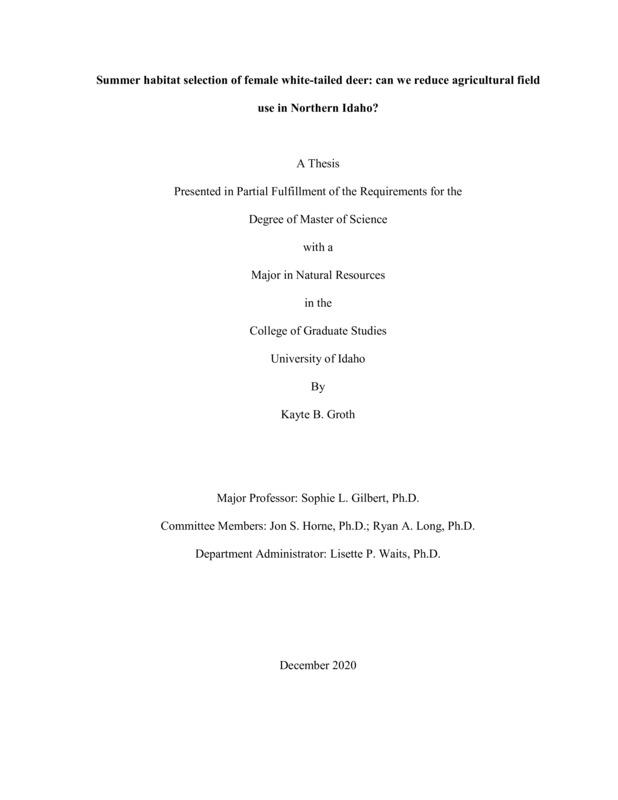Summer habitat selection of female white-tailed deer: can we reduce agricultural field use in Northern Idaho?
Groth, Kayte BreAnne. (2020-12). Summer habitat selection of female white-tailed deer: can we reduce agricultural field use in Northern Idaho?. Theses and Dissertations Collection, University of Idaho Library Digital Collections. https://www.lib.uidaho.edu/digital/etd/items/groth_idaho_0089n_12011.html
- Title:
- Summer habitat selection of female white-tailed deer: can we reduce agricultural field use in Northern Idaho?
- Author:
- Groth, Kayte BreAnne
- Date:
- 2020-12
- Program:
- Natural Resources
- Subject Category:
- Wildlife management
- Abstract:
-
Big game species in Northern Idaho provide both ecological and economic benefits to a variety of societal groups. In the Clearwater region, white-tailed deer (Odocoileus virginianus; WTD) are one of the main big game species that recreationalists seek, yet are also known to cause significant damage to high-profit crops. Although research is abundant in other parts of WTD range, research on habitat and behavioral ecology of WTD in Northern Idaho is lacking. The goal of our research was to investigate WTD ecology via fine-scale habitat selection and develop management tools that reduce crop damage through behavioral modifications. Behavioral modifications were intended to reduce the amount of time individuals spent in agricultural fields, and ultimately reduce the amount of damage caused. We used step selection functions to analyze summer home range (May 15 – October 6) habitat selection of 49 adult WTD females in 2017 and 2018, and analyzed data during 5 diel time periods: morning/evening, midday, crepuscular, peak, and night. We found that during the midday and nighttime hours WTD selected to be closer to agricultural field edges, shrublands, and forested habitat types. Similarly, WTD selected to be near agricultural field edges and shrublands during morning/evening hours, yet further away from forested habitat types. During peak hours (i.e., highest occurrence of WTD in agricultural fields), WTD selected for gentle slopes, larger distances from forested habitat, and to be closer to agricultural field edges, roads, and all 3 prominent crop types (hay, pulse, and winter wheat). Lastly, during crepuscular hours WTD selected for gentle slopes, larger distances from pulse crop fields, and closer to agricultural field edges, roads, grassland, and forested habitat types. We also investigated large scale movement patterns and seasonal migration timing. We found that approximately half of the GPS-collared individuals migrated each year, but that there were differences in movement behaviors between the 2 sub-populations. Half of the GPS-collared individuals resided on private land, while the other half resided on an Idaho Department of Fish and Game Access Yes land parcel subject to public hunting pressure. We found that 62% of private land individuals were resident, while 35% were migratory. The opposite was true for the Access Yes individuals with 38% remaining residents, while 65% were migratory. Not only did more publically-accessible individuals migrate, but they also migrated on average 2 months earlier than migrants from the other sub-population. Our behavior modification deterrent treatments consisted of a fear-enhancing deterrent (a combination of 3 components that target auditory, olfactory, and visual cues), a physical exclusion deterrent (4-strand electric partial fence), and a taste-aversion compound (lithium chloride, LiCl). Efficacy of the fear-enhancing deterrent was determined through counts of used GPS locations in agricultural fields, and distance from deterrent metrics. We found that the weekly number of GPS locations within treated fields was reduced by 23% after the treatment had been deployed, and that on average, GPS-collared individuals preferred to be ~35m further away from deterrent systems when they were on compared to when they were off. We used a log linear model to evaluate our physical exclusion deterrent, and found that WTD crossings (entering or exiting an agricultural field) were reduced by 30% when the fence was up and on compared to when it was down and off. Finally, although we were not able to actively deploy LiCl in a field setting or determine its efficacy as a deterrent treatment for WTD, we were able to investigate muscle and organ tissue withdrawal times and toxicity at a low and high dosage of ingested LiCl over a 10-day period in an analogous small ruminant, domestic sheep. Linear regression models were used to determine that peak lithium concentration (7.8µg/g) occurred in muscle tissues 25 hours post-ingestion at a low dosage of 150mg/kg body weight. At a high dosage (450mg/kg body weight), lithium concentration peaked (45µg/g) 73 hours post-ingestion, and resulted in a high mortality rate, raising concerns over the use of LiCl in a field setting except at low dosages. Overall, this research provides insight to WTD ecology and space-use patterns in Northern Idaho, which can help guide management strategies and actions to reduce WTD crop depredations while aiding in keeping a positive working relationship between agricultural producers, wildlife enthusiasts, and wildlife agencies.
- Description:
- masters, M.S., Natural Resources -- University of Idaho - College of Graduate Studies, 2020-12
- Major Professor:
- Gilbert, Sophie L
- Committee:
- Horne, Jon S; Long, Ryan A
- Defense Date:
- 2020-12
- Identifier:
- Groth_idaho_0089N_12011
- Type:
- Text
- Format Original:
- Format:
- application/pdf
- Rights:
- In Copyright - Educational Use Permitted. For more information, please contact University of Idaho Library Special Collections and Archives Department at libspec@uidaho.edu.
- Standardized Rights:
- http://rightsstatements.org/vocab/InC-EDU/1.0/

